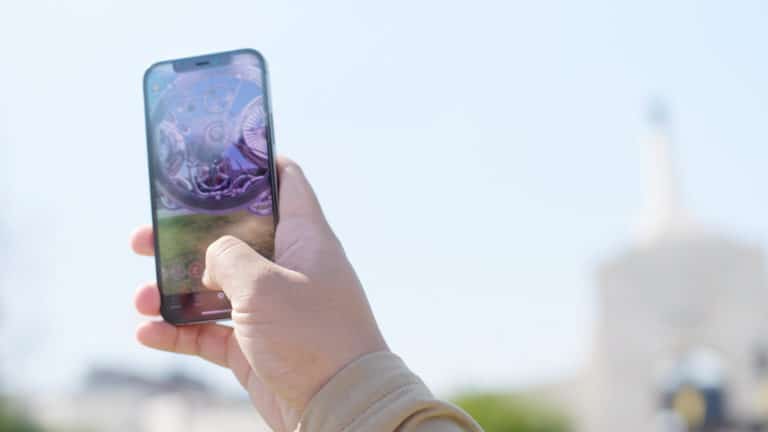
AR continues to gradually penetrate consumer markets. It shows the most traction and user engagement in location based gaming — largely due to the outlier that is Pokémon Go — as well as social lenses. Snap leads the way with the latter, including monetization.
It turns out that the same factors that make social lenses viral and engaging make them an optimal vehicle for brand marketing. That is, they’re immersive and bring a certain fun factor that boosts session lengths and other performance metrics in sponsored lens campaigns.
But fun and novelty wear off. Will AR gain other attributes and selling points as it matures as a utility? We’re already seeing that with product try-ons, as well as “search what you see” visual search. As we’ve examined, emerging tech usually follows this path from novelty to utility.
To pinpoint where we are in that evolutionary path, Snap recently held a virtual event to highlight data from its recent study with Deloitte.* It includes consumer survey research as well as market-sizing projections and is the focus of this week’s XR Talks (video & takeaways below).
500 Million Minutes
So what did the report uncover? To validate some of the above points, a majority of AR users report that they see the technology as a toy, but 81 percent hope to use it as a practical tool. Meanwhile, interacting with products in AR leads to 94 percent higher conversion rates.
As for usage volumes, Snap’s own data show that more than 4.5 billion AR photos and/or videos are taken daily by consumers. Deloitte projects this to grow to 17.7 billion by 2025, a 40 percent compound annual growth rate that’s driven by escalating AR awareness.
To throw out some more usage stats, there are more than 500 million minutes of AR play time per day on Snapchat. This potentially says more about AR’s value to brands in that lenses are active for long session lengths, which engenders depth of brand engagement and impression.
Lastly, AR is showing signs in its early lifecycle that mirror early smartphone adoption patterns. Delloite theorizes that the technology will continue to follow mobile’s growth curve. Specifically, it’s estimated to grow from 24 percent consumer adoption today to about 75 percent by 2025.
From Toy to Totality
If consumer AR does indeed follow smartphones’ early growth curve, it will be accelerated by a few factors including 5G and other enablers such as LiDAR. As this progresses Deloitte believes AR will follow a path from tech to toy to tool to totality. We’re currently between “toy and “tool.”
To break these stages down a bit, the “tech” stage is when a new technology is introduced and starts to gain traction via osmosis. In other words, adoption is driven by integration with existing consumer behaviors. This happened with AR lenses as an enhancement to selfie sharing.
Moving on to the “toy” stage, AR has gained a great deal of traction as a novelty with a certain fun factor. This is what makes AR lenses so viral and engaging as people share them with friends due to their comical and whimsical qualities. But again, this isn’t necessarily sustainable.
Technologies that advance to the “tool” stage grab the baton, and accelerate adoption by proving themselves as practical utilities. Historical examples include search and email. AR is showing these qualities in use cases like, again, immersive shopping (especially in a pandemic).
The final stage of self-actualization for new technologies is “totality.” This is when the technology reaches ubiquity as a mundane part of everyday life. It’s so entwined with consumer and enterprise behavior that it’s not really a technology….it’s just there (like smartphones).
Activation Energy
These stages, as well as AR’s mobile-like growth curve, are projections and should be taken with a grain of salt. But there’s ample evidence in consumer survey data and live market activity to make these examinations defensible. AR isn’t yet groundbreaking but it’s pacing well.
So what currently stands in its way? Deloitte points to a few things that still need some work. For one, there’s a lack of content. Even though platforms like Snap’s Lens studio accelerate AR content libraries by democratizing its creation, there’s still an aggregate market gap.
For example, as we’ve examined, one gating factor to AR marketing (or camera commerce as we call it), is the 3D content pipeline. In order to have AR experiences for a given brand’s product catalogs, they first need 3D product models – part of the value chain that continues to develop.
Another key barrier is friction. Though AR is engaging and fun, it isn’t yet proven enough to expect consumers to jump through hoops or search for it. There’s still “activation energy” in things like app downloads that need to be streamlined, especially in dynamic scenarios like a store aisle.
Snap has reduced friction in its inherent UX to open right to the camera. This is one reason why it’s been so successful with AR. Another poster child of reducing friction is the broader world of web AR, given browser-based activation. AR will continue to evolve along all these points.
We’ll pause there and cue the full video below…
*Disclosure: the author of this article advised Snap and Delloite during the production of its report.






